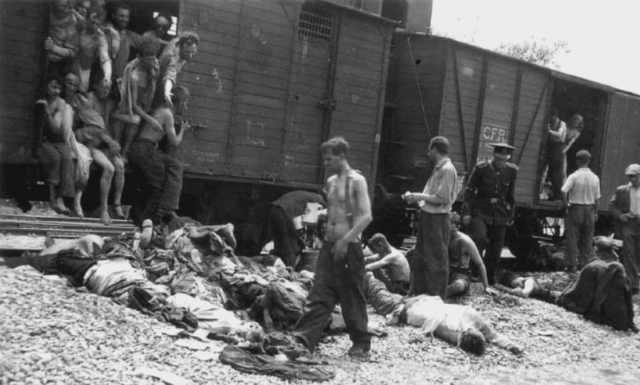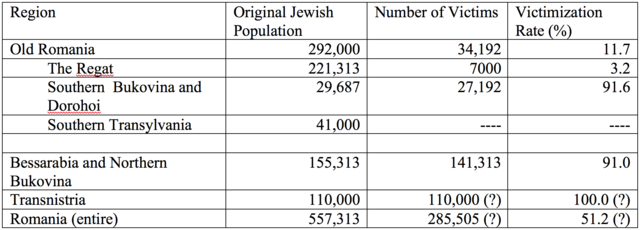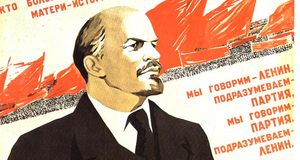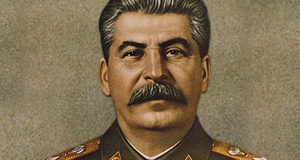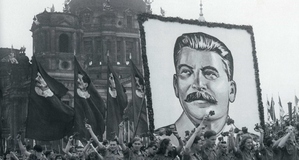Featured Article:The Holocaust in Romania: The Extermination and Protection of the Jews Under Antonescu's Regime
By
2014, Vol. 6 No. 12 | pg. 1/2 | »
KEYWORDS:
Between 1941 and 1944, Romania was responsible for exterminating approximately 300,000 Jews, giving it the sinister distinction of ranking second only to Germany in terms of the number of Jews murdered during the Second World War.1 Marshal Ion Antonescu,2 military dictator of Romania from 1940-1944, advocated a policy of ethnic cleansing to purify the Romanian nation no less radical than Hitler’s own racial ideology. Unlike most of Hitler’s erstwhile allies, who in practice were merely German satellites, Romania was able to maintain its independence and freedom of action not only through military cooperation with Hitler against the Soviet Union, but also by using its vast reserves of oil, which Germany’s war effort was dependent upon, as economic leverage. Antonescu and his regime were responsible for the death of roughly 300,000 Jews, a figure second only to Nazi Germany. As such, Antonescu’s policies of ethnic cleansing were carried out independently, though with the approval, of Hitler’s Third Reich, making Romania’s persecution of Jews a distinct chapter in the history of the Holocaust. Yet, these atrocities were largely confined to the areas of present day South-West Ukraine, namely Bessarabia, Northern Bukovina, and Transnistria, which Romania conquered from the Soviet Union in the summer of 1941. These massacres were largely an outgrowth of an ingrained suspicion of ethnic minorities, a tradition of anti-Semitism among ethnic Romanians, as well as Antonescu’s own anti-Semitic ideology of national purification and ethnic cleansing.Though Antonescu’s regime actively persecuted the native Jewish population in “Old” Romania,3 they were not massacred or deported as in South-West Ukraine. This contradiction is easier to understand when one considers the practical problems facing Antonescu’s regime, namely the fear of economic collapse following the wholesale removal of Jews from Romanian economic life, and after 1942 the prospect of defeat on the eastern front and the necessity of preparing for a possible postwar peace conference. The Iaşi death trains are estimated to have killed between eight and fourteen thousand Jews in the summer of 1941. Over 100 people were stuffed into each car, and many died of thirst, starvation, and suffocation aboard two trains that for eight days travelled back and forth across the countryside, stopping only to discard the dead (as photographed). It is impossible to understand this seeming contradiction in Romania’s Jewish policy unless one considers the character of its leader, Marshal Ion Antonescu, who presided over a military dictatorship in the country from 1940 to 1944. Antonescu was a professional soldier with a long career in the Romanian Army. He served with distinction during the First World War and quickly rose through the ranks, serving as Army Chief of Staff from 1933-34 and Minister of War from 1937-38. Antonescu chose not to kill or deport the vast majority of the Jews living in Old Romania in order to prevent the collapse of the Romanian economy and to improve Romania’s bargaining position at a possible post-war peace conference. Though forced into internal confinement by King Carol II in the summer of 1940 over his criticism of Carol’s secession of Bessarabia and Northern Bukovina to the Soviet Union and Transylvania to Hungary, Antonescu was recalled to office in September after the King was faced by mass nationalist protests. Agreeing to form a new government only after receiving dictatorial powers, Antonescu promptly deposed Carol II and replaced him with a minor, Mikai I. Suppressing a revolt by the Nazi-sponsored Iron Guard Legionaries4 in January 1941, Antonescu allied Romania with Nazi Germany, signing the Tripartite Pact and Anti-Comintern Pact, in the hopes of restoring Romania’s territorial losses of 1940 through collaboration with Hitler.5 Antonescu was a fervent anti-Semite, viewing the Jews as the primary enemy of the Romanian nation. With regard to the Jews, Antonescu asserted that, “the Jewish people [have] embezzled and impoverished, speculated on and impeded the development of the Romanian people for several centuries; the need to free us from this plague is self-evident.”6 He even viewed Romania’s participation in Operation Barbarossa as a campaign against the Jews, stating in a letter to Mikai Antonescu that, “Everybody should understand that this is not a struggle with the Slavs but one with the Jews. It is a fight to the death.”7 Antonescu advocated a policy of racial purification of the Romanian nation, and Romania’s participation in Hitler’s war against the Soviet Union provided Antonescu with the opportunity to put these ideas into practice. That is not to say, however, that Antonescu’s worldview was entirely dominated by racial considerations; indeed Antonescu can be described as a conservative nationalist whose priority was to restore the territorial integrity of the Romanian nation after the humiliating territorial capitulations to the Soviet Union and Hungary.8 Antonescu’s xenophobia and anti-Semitism did not exist in a vacuum; rather they must be seen as indicative of the prevailing attitudes of Romania’s elite as well as part of a centuries long tradition of anti-Semitism in Romania. For example, there is no evidence of protest on the part of any of Antonescu’s ministers in the minutes of the Council of Ministers against either his tirades against the Jews or his desire to ethnically cleanse Romania.9 Prior to the First World War, ethnic minorities compromised only about 8 percent of Romania’s population. However, the Treaty of Versailles almost doubled Romania’s pre-war territory, which resulted in the percentage of ethnic minorities increasing from 8 to 28 percent of Romania’s population by 1930. The Jews were one of Romania’s largest and most visible minority groups and by 1930 numbered approximately 600,000-700,000, or 4 percent of Romania’s population. During the 1930s, a wide consensus of Romania’s governing elite had come to view these various minorities, including the Jews, as not merely disloyal but also as contaminating the racial pool of ethnic Romanians. The notion that it was necessary to cleanse the ethnic pool in order to permanently eliminate the degenerative elements within Romania contributed to the growing radicalization of government policy towards the Jews. The Iron Guard Legionaries, for instance, advocated a policy of “racial engineering,” which included deporting Romania’s Jews to concentration camps.10 This came to a head in a series of pogroms throughout Old Romania, most famously in Bucharest in January 1941 in which 500 Jews were killed, and at Iasi in June 1941, in which 8,000-12,000 Jews were massacred. In both instances Antonescu and his government either turned a blind eye to the local perpetrators, or in the case of Iasi, encouraged and aided local officials in rounding up the Jews to be shot.11 Unlike most of Hitler’s nominal allies who were viewed and treated as mere satellites of the Third Reich, Romania was able to retain its sovereignty throughout most of the war. This was primarily because of its active military cooperation with Hitler on the Eastern Front.12 During Antonescu’s struggle with the fascist Legionaries, Hitler sided with Antonescu and refused to intervene while the later crushed an attempted revolt with Legionaries, despite the objections of figures such as Goebbels and Himmler. Hitler appears to have had a great deal of respect for Antonescu, seeing in him the only individual who could effectively control the Romanian Army, which could be used as a powerful asset in Hitler’s planned invasion of the Soviet Union. Hitler also seems to have taken Antonescu partly into his confidence, revealing to the Marshal his plans for Operation Barbarossa in January 1941, and his intention to exterminate the Jews of Europe in March 1941. On 22 June 1941, Germany invaded the Soviet Union. Antonescu, honoring his alliance with Hitler, contributed 585,000 soldiers to the attack by invading south western Ukraine. As a reward for Romania’s military contributions to Operation Barbarossa, Romania received the territories of Bessarabia and Northern Bukovina (which had been lost to the Soviet Union in 1940 as per the Nazi-Soviet Non-Aggression Pact) and Transnistria. As a result, Romania gained an additional 250,000 Jews. These Jews comprised roughly 55 percent of the enlarged Romania’s total Jewish population (35 percent in Bessarabia and Northern Bukovina and 20 percent in Transnistria).13 Antonescu was able to act independently of Germany not only because of Romania’s substantial military contribution in Hitler’s war against the Soviet Union, but also because Romania possessed vital raw resources essential to the German war effort, primarily oil. Germany, lacking adequate natural deposits of crude oil, was heavily dependent on imports of oil to fulfil civilian and military consumption needs. The declaration of war by France and Britain on Germany in 1939 ensured that Germany was unable to import refined oil from overseas, and Romania thereafter became Germany’s principle source of oil until mid-1944. In May 1940 Germany and Romania signed an oil pact, increasing Germany’s share of Romania’s oil exports to 44 percent. Even the imports from the Soviet Union under the Nazi-Soviet Non-Aggression Pact were minuscule compared to Romania’s exports of refined oil to Germany (by 1941, Romanian oil accounted for 94 percent of Germany’s oil imports, see Table I below for further comparisons). As such, Antonescu possessed what most of Germany’s other allies lacked; economic leverage. By maintaining a continuous supply of oil for the German Wehrmacht, Antonescu was able to preserve Romania’s sovereignty and his own freedom of action with regard to domestic policy, including his policies vis-à-vis the Jews of Romania.14 Table I: German Sources of Oil Supply (in thousand tons)21 Antonescu was aware of Hitler's intention to exterminate the Jews of Europe as early March 1941. However, it would be wrong to suggest that Antonescu’s policies to the Jews were either directed from, or influenced by, Berlin. Rather, they were a product of Antonescu’s own anti-Semitic world view, in which the need to purify the nation of Jews and other minorities was seen as essential for Romania`s future survival. It is against this backdrop that Antonescu’s policies of extermination against the Jews in Bessarabia, Northern Bukovina, and Transnistria during the summer and fall of 1941 must be viewed. These territories, newly reconquered from the Soviet Union, provided a laboratory in which Antonescu’s policy of racial purification could be carried out. The cleansing of these provinces took two forms; mass shootings and deportation to ghettos and concentration camps15 where the survivors were to be starved to death. In the first wave of the extermination campaign in the summer of 1941, the Romanian Army, aided by local officials and Ukrainians, carried out a wave of massacres and pogroms throughout Southwest Ukraine. Iasi, mentioned above, was merely the first of these massacres; other notable instances of mass shootings occurred in Odessa and Kishniviv. In each case thousands of Jews were rounded by the Romanian Army and local police forces and shot en masse. The massacres were largely uncoordinated, and although the ruthlessness with which the Romanian Army slaughtered the Ukrainian and Romanian Jews won Hitler’s approval, they nevertheless earned the disdain of many SS officials, who disparaged the primitive techniques employed by the Romanians.16 Transnistria was the centre of Antonescu’s extermination campaign; roughly 150,000 of the surviving Ukrainian and Romanian Jews from Bessarabia and Northern Bukovina were deported to this territory between the Bug and Dniester rivers. Almost all of them perished, giving Transnistria the sinister nickname as the Romanian Auschwitz. Deportation itself was also a death sentence, with thousands of Jews dying en route to Transnistria in overcrowded railway cars. Romania developed an extensive system of ghettos (referred to as colonies) and concentration camps, located at Bogdanovka, Domanevka, Akhmentchetkha, Pechora and Vapniarka in the fall and winter of 1941.Throughout the winter of 1941-42, the Romanian Army, aided by local Ukrainian auxiliaries, began to cleanse the camps at Pechora and Vapniarka, while a typhus epidemic ravaged the colony around Mogilev. The Jews that survived this campaign were left to slowly die from starvation over the following two years.17 In total, Antonescu’s government exterminated approximately 50 percent of the Jewish population in Romania. However, this figure is misleading. While roughly 95 percent of the Jewish population of Bessarabia, Northern Bukovina, and Transnistria were killed in 1941-42, only about 11 percent of the Jews in Old Romania were killed during the entire war (see Table II for further comparison). That is not to say that it was Antonescu’s intent to spare the Jews of Old Romania, indeed quite the contrary. Flushed with victory against the Soviet Union, the cleansing of Bessarabia, Northern Bukovina, and Transnistria was intended to be but the first step in a wider program by which all of Romania was to be cleansed of the Jew’s parasitic influence. And yet, Romania’s purification campaign came to a gradual halt in 1942. Though Antonescu had agreed tentatively in the fall of 1941 to deport the remainder of Romania’s Jews to German concentration camps, these plans never bore fruit and were eventually cancelled in the following year. In spite of Antonescu’s fervent anti-Semitism and commitment to an ideology of racial purification of the Romanian nation, the Jews of Old Romania largely escaped the policy of extermination or deportation enacted in the newly acquired regions of southern Ukraine.18 Table II: Victimization of Jews in Romania by Region22 One reason why Antonescu’s policies were more moderate towards Jews within the territories of Old Romania was the fear of economic collapse. This was particularly true when one examines Antonescu’s attitude toward the policy of Romanianization. Favoured by the Iron Guard Legionaries, Romanianization was a policy designed to confiscate the property of the Jews, completely exclude them from the economic life of Romania and replace them with ethnic Romanians. Though not opposed to Romanianization per se, Antonescu favoured a more gradual process of exclusion for a number of reasons.Continued on Next Page » Suggested Reading from Inquiries Journal
Inquiries Journal provides undergraduate and graduate students around the world a platform for the wide dissemination of academic work over a range of core disciplines. Representing the work of students from hundreds of institutions around the globe, Inquiries Journal's large database of academic articles is completely free. Learn more | Blog | Submit Latest in History |

